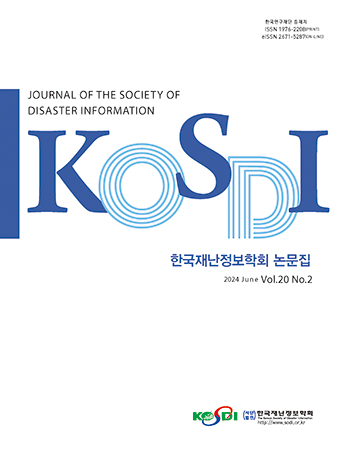Original Article
Abstract
References
Information
Purpose: Fire load analysis was conducted to secure basic data for evaluating fire risk of educational facilities. In order to calculate the fire load through a preliminary survey, basic data related to the fire load of school facilities were collected. Method: The basic data were the definition and types of fire loads, combustion heat data for the calculation of fire loads. The fire load was evaluated by multiplying the combustion heat by the weight of the combustibles in the compartment when calculating the fire load. Result: As for the fixed combustible materials of A-elementary school, the floor was mainly made of wood, in consideration of emotion and safety in the classroom, music room, and school office, and the rest of the compartments were made of stone. The ceiling and walls were made of gypsum board and concrete, so they were not combustible. The typical inflammable items in each room were desks, chairs, and lockers in the classroom, and the laboratory equipment box and experimental tool box were the main components in the science room, and books, bookshelves, and reading equipment occupied a large proportion in the library room. Conclusion: 'The fire loads of A-elementary' schools according to the combustibles loaded were in the order of library, computer room, English learning room, teacher's office, general classroom, science hall, and music room.
연구목적: 교육시설 화재위험성 평가를 위한 기초 데이터 확보를 위하여 화재하중 분석하였다. 사전조사로 화재하중을 산정하기 위해 학교시설의 화재하중과 관련된 기초자료를 수집하였다. 연구방법: 기초자료는 화재하중의 정의 및 종류, 화재하중 산정을 위한 연소열 데이터 화재하중에 대한 선행연구를 통하여 진행하였고 화재하중 산출시 구획실에 존재하는 가연물 중량에 해당 연소열을 곱하여 산정하였다. 연구결과: A 초등학교의 고정가연물은 교실, 음악실, 교무실은 정서나 안전을 고려하여 바닥이 주로 목재로 이루어져 있었으며, 나머지 구획실은 석재로 이루어졌다. 천장과 벽은 석고보드, 콘크리트로 되어있어 가연물에 속하지 않았다. 각 실별로 대표적인 적재가연물은 교실은 책상, 의자, 사물함 등으로 나타났으며 과학실은 실험기구함, 실험도구함이 주를 이루어었으며 도서실은 책과 서가, 열람기구 등이 큰 비중을 차지하였다. 결론: A 초등학교의 적재가연물에 따른 적재화재하중은 도서실, 컴퓨터실, 영어학습실, 교무실, 일반교실, 과학관, 음악실의 순으로 나타났다.
- E-Fire Statistics (2003). National Fire Information Center of the National Fire Service Agency.
- Kim, D. (2018). A Study on the Calculation of Fire Loads by Building Use. Master Degree, Konkuk University.
- Lee, P.-G. Choi, I., Kim, H.-S. (2013). "A study on application of fire load by use for fire safety of buildings: Field survey results for domestic fire load evaluation focused on." Journal of the Architectural Institute of Korea 2003, Vol. 19, No. 1, pp. 78-84.
- Quintiere, J.G. (2007). Fire Engineering Principles. Book Publishing Fairy Tale Technology, CRC Press, USA.
- Roh, H. (2016). "Korean institute of fire science and engineering." Fire Magazine 2016, Vol. 8, No. 2, p. 51.
- Yeo, Y. (2003). Water-based Fire Extinguishing System Engineering. Korea Fire Research Institute Fire Engineering, Seoul, Korea, pp. 104-203.
- Publisher :The Korean Society of Disaster Information
- Publisher(Ko) :한국재난정보학회
- Journal Title :Journal of the Society of Disaster Information
- Journal Title(Ko) :한국재난정보학회논문집
- Volume : 17
- No :2
- Pages :351-364
- DOI :https://doi.org/10.15683/kosdi.2021.6.30.351




 Journal of the Society of Disaster Information
Journal of the Society of Disaster Information







